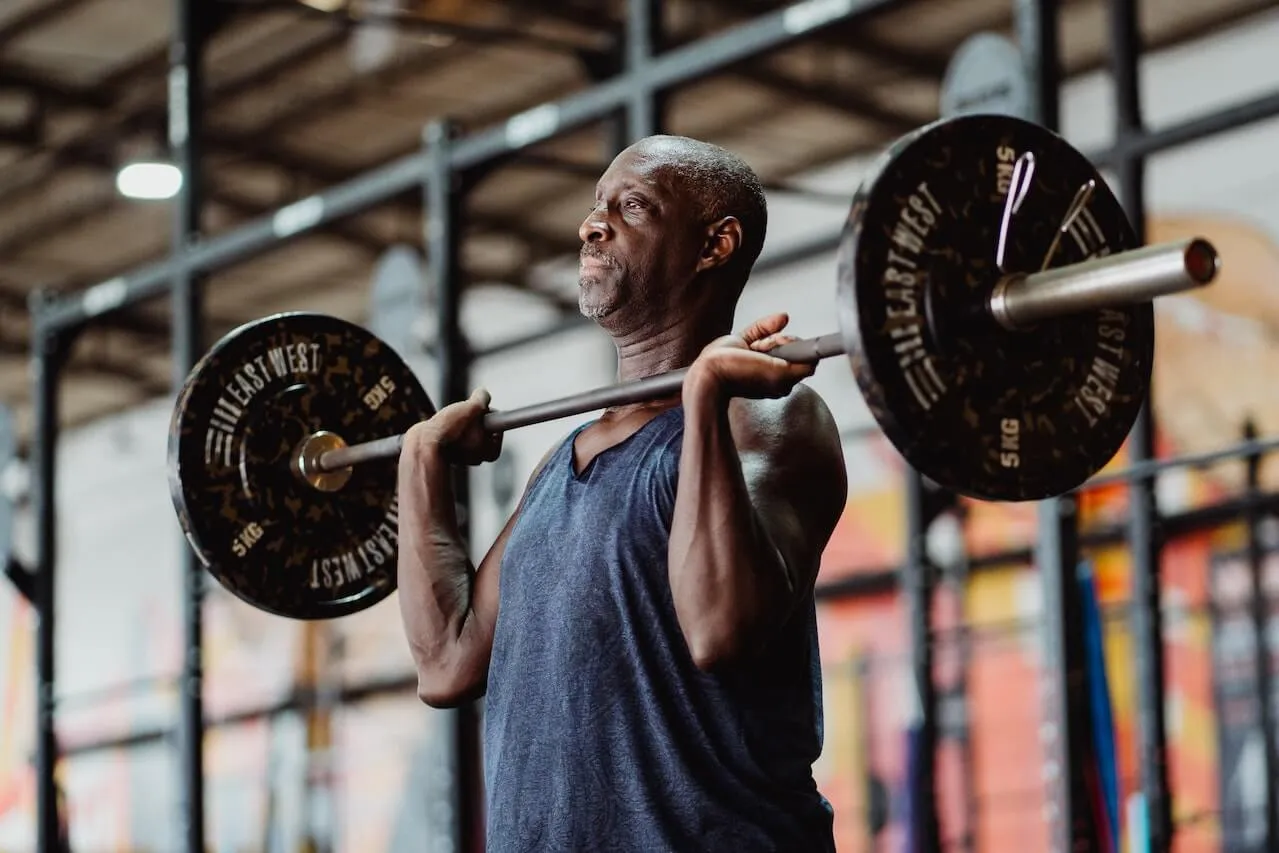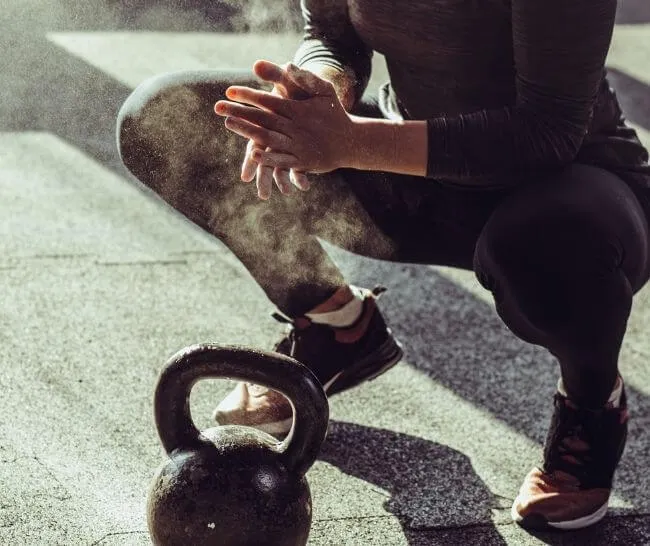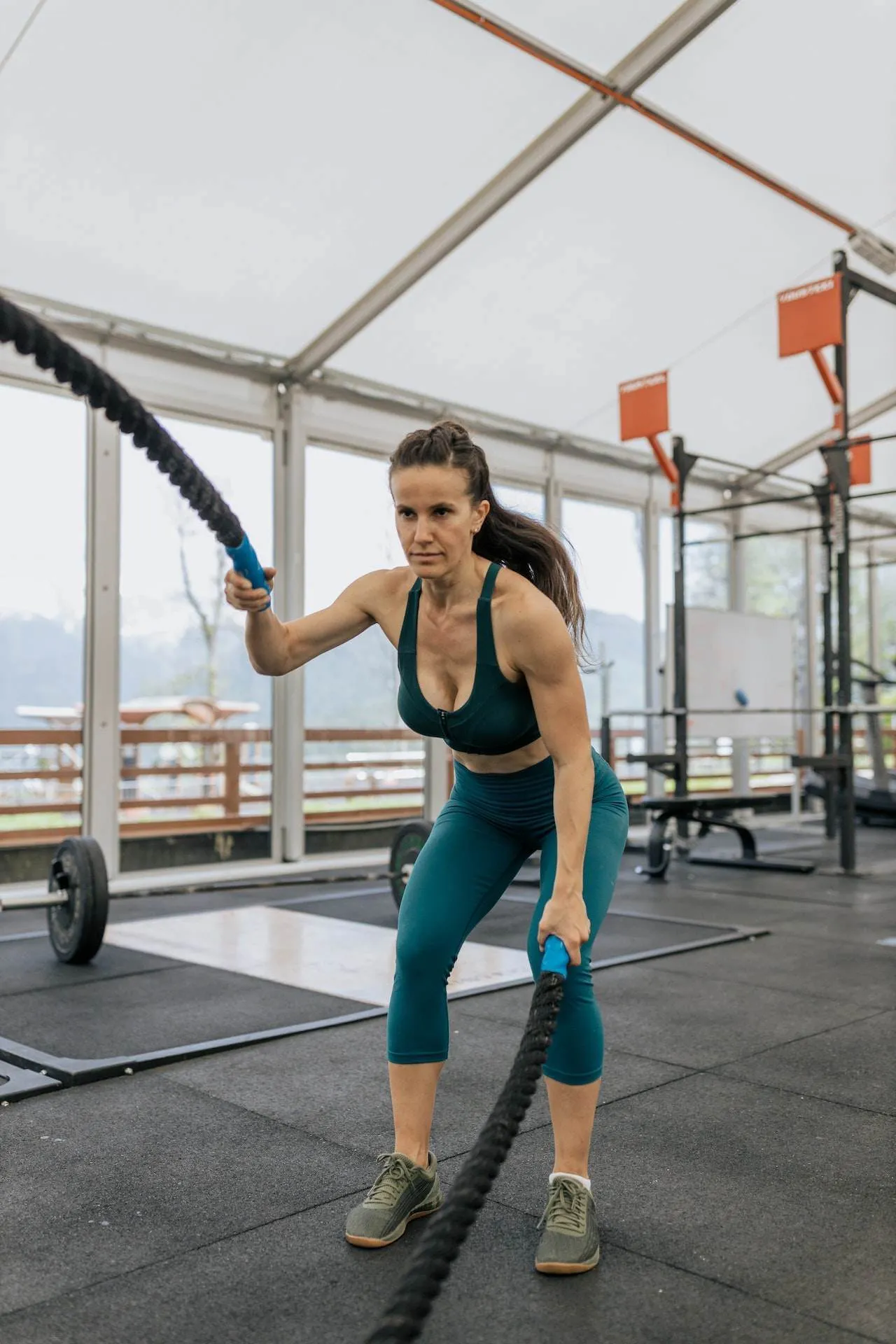When discussing exercise, the terms “aerobic” and “anaerobic” refer to the specific physiological systems and fuel sources used to generate energy. Aerobic systems require the use of oxygen; anaerobic systems do not. Both aerobic and anaerobic are beneficial for maintaining a healthy lifestyle and targeting weight loss goals. This article will discuss the differences between aerobic and anaerobic exercise, which might be better for weight loss, and how you can incorporate both into your fitness routine.
What is Aerobic Exercise?
Aerobic exercise is any low, moderate, and vigorous-intensity physical activity performed for over three minutes that requires oxygen to create energy. If we think about heart rate zones, aerobic exercise generally falls into the 50-85 percent of your maximum heart rate, or Zones 1 - 4. The aerobic system produces significantly more energy (as ATP) with the use of oxygen, however, at a very slow rate.
If your intensity increases to a higher level (i.e., Zone 5 training, sprinting, heavy weight lifting), you may utilize more anaerobic systems to make energy as quickly as possible. Aerobic exercise can be the easiest form of exercise if you are just beginning your journey to a healthier lifestyle. It is best to start small, use intervals, and monitor your heart rate to ensure you are not going into an anaerobic state.
{{mid-cta}}
9 Types of Aerobic Exercises
Here are some examples of aerobic activities to try, but make sure it is an exercise you can do safely for at least 10 minutes (or longer). You can always take breaks or reduce the intensity if needed. Wearing a heart rate monitor will help you determine if your intensity is too high or too low.
- Hiking: depending on the elevation or type of terrain, hiking can be considered an easy, medium, or vigorous activity. Make sure to research the area or trails before going for a hike.
- Jogging: a general rule is if your pace is less than 6 miles per hour (slower than 10 min/mile), you are jogging.
- Running: anything faster than 6 miles per hour is considered running and may be more intense for most people.
- Cycling: indoor and outdoor cycling is great for low-impact cardiovascular training.
- Swimming: whether swimming laps or taking a water aerobics class, water-based exercise is another great form of low-impact exercise.
- Rowing: using a rowing machine is a full-body exercise, so using the correct form to reduce injuries is important.
- Dancing: Zumba classes, Jazzercise, or any form of dance that gets your heart rate pumping for long periods is a fun way to get in aerobic exercise.
- Brisk Walking (about 3 miles per hour): walking at a faster pace increases your heart rate to a level that targets your aerobic systems and can even help with weight loss.
- Pilates and yoga: certain classes are done at a faster pace or in a heated room, making them more intense and aerobically challenging.
How Often Should You Do Aerobic Exercise?
The US Department of Health recommends getting 150 minutes of moderate-intensity or 75 minutes of vigorous-intensity aerobic exercise each week. In comparison, the American Heart Association recommends performing at least 30 minutes of aerobic exercise five to seven days per week.1,2 Therefore, it is safe to do aerobic exercise daily; however, this depends on your current fitness level and the intensity of each workout.
The same recommendations by the US Department of Health states that up to 300 minutes of moderate-intensity aerobic exercise is an effective target if your goal is weight loss and blood sugar control.2 However, an activity done for more than this recommended time frame may not lead to better outcomes. There is such a thing as “too much” when it comes to exercise, so make sure you are giving yourself proper rest and talk to your doctor, personal trainer, or other health and wellness practitioner about what is right for you.

What is Anaerobic Exercise?
Anaerobic exercise differs from aerobic exercise because it is done for much shorter durations at higher intensities. Anaerobic exercise does not require the use of oxygen to create energy, which is why it can only be done for shorter intervals (less than two minutes). The body utilizes glucose as its main energy source in these activities because it is very easy and quick to break down. This is why HIIT-type workouts can benefit those needing to reduce their blood sugar levels and improve overall insulin sensitivity.3
6 Types of Anaerobic Exercises
It is true that some overlap between anaerobic and aerobic occurs during certain activities (i.e., running, weight training) as it depends on the intensity at which you are performing the activity. For example, running at an easy pace for 30 minutes will be mostly aerobic; however, try a few 20-second sprints, and this will be mostly anaerobic. The higher the intensity and the shorter the duration, the more anaerobic you will become. Here are a few examples of anaerobic exercise:
- Sprinting - this is the highest intensity and speed at which most people can run for less than 2 minutes.
- Weightlifting - light calisthenics is likely not intense enough to target your anaerobic system. Lifting near-maximal weights for short durations or repetitions will hit your anaerobic zones.
- HIIT (high-intensity interval training) - this gets confusing because classes last longer than three minutes; however, high-intensity work is typically between 20 seconds to one minute at a time with plenty of rest or active recovery between rounds.
- Squat jumps
- Box jumps
- Plyometrics includes jumping activities or other high-impact exercises seen in sports or HIIT-type classes.
How Often Should You Do Anaerobic Exercise?
Since anaerobic exercise is inherently more intense than aerobic, take caution in doing too much and talk with your healthcare provider beforehand. The US Department of Health recommends that adults get at least two to three days of strength training during the week focusing on each muscle group. Start with two to three sets of 8-12 repetitions using a weight heavy enough that makes you feel fatigued by the last few reps of the final set. Then, take one to two minutes of rest between sets and exercises to allow your body to recover and replenish for the next round.
What are the Differences Between Aerobic and Anaerobic Exercise?
The main differences between aerobic and anaerobic exercise are the type of fuel used to create energy and the need for oxygen. Aerobic exercise requires the use of oxygen to break down carbohydrates, fats, and proteins to make energy in the form of ATP. Your aerobic systems can make continuous amounts of ATP at a very slow and steady rate. Due to the quick, powerful movements involved in anaerobic exercise, the slow and steady aerobic system just isn’t enough. Your anaerobic system works quickly to break down the glucose in your bloodstream and muscles to create ATP, which does not require oxygen. Unfortunately, we cannot sustain this form of energy production for very long due to the high levels of byproducts that cause fatigue.
Both systems work simultaneously during exercise; however, one will take the lead depending on the structure and type of your workout. If you are targeting a Zone 2 workout for 30 minutes on your stationary bike, then this is considered aerobic exercise. You are doing anaerobic exercise if you are lifting heavy weights using sets, reps, and rest breaks. Lastly, aerobic exercise helps increase your cardiovascular endurance, boosts your mitochondrial density, and improves your heart and lungs' efficiency. Anaerobic exercise will help increase muscle strength and power which is even more important as we age to reduce the risk of chronic disease and falls.
Aerobic vs. Anaerobic: Similarities
Both aerobic and anaerobic exercise are beneficial for improving our overall health. Researchers have found that both systems work together to help lower blood sugar, improve mental health, aid in weight loss and weight management, and reduce the risk of cardiovascular disease.4,5 This why the CDC and US Department of Health recommends obtaining 75 to 150 minutes of vigorous to moderate intensity activity (respectively) in addition to two to three days per week of strength training if your goal is to improve your overall health and longevity.
9 Surprising Benefits of Aerobic and Anaerobic Exercise
Here are some surprising benefits of aerobic and anaerobic exercise that you may not have yet to consider before reading this article.
Benefits of Aerobic Exercise
- Reduces risk of chronic illness: illnesses such as cardiovascular disease, type II diabetes, hypertension, and COPD can be improved by engaging in regular aerobic physical activity due to the improvement in heart function, cholesterol levels, and metabolic health.6
- Less stress: many studies have shown the positive effects of regular aerobic exercise on chronic stress, anxiety, depression, and other mental health diagnoses.5
- Weight management: regular aerobic exercise has been found to be the best way to lose weight and manage a healthy weight by reducing overall fat mass and body mass.7
- Helps with sleep: a systematic review in 2010 found that regular aerobic exercise was a successful treatment for adults struggling with poor sleep quality and insomnia.8
Benefits of Anaerobic Exercise

- Better VO2 max: studies have shown anaerobic exercise to be more effective at increasing VO2 max due to the improved efficiency at using oxygen to create energy and improved stroke volume from the heart.9
- More muscle power: muscle power is gained by lifting very heavy weights as quickly as possible. These types of activities include cross-fit type exercises or powerlifting, where the focus is strengthening type II muscle fibers. By training these muscles specifically, you will improve your overall muscle power.
- Shorter workouts maximize results: If you are strapped for time to fit in exercise to your day but still want to gain all the benefits, then choosing anaerobic exercise can help you maximize your results in a shorter time.10 This is one reason why HIIT-style workouts have become so popular and effective.
- Improved cardiovascular health: high-intensity resistance training has been found to improve heart rate variability and muscle performance in patients with coronary artery disease.11
- Gaining bone mass and density: studies have found that even in older adult populations, higher-intensity resistance training may be more effective in improving bone mineral density than low-impact exercise alone.12
Why is Anaerobic Exercise More Effective for Weight Loss?
Most of us are interested in losing fat mass when we think about weight loss. Aerobic exercise targets slow twitch muscle fibers and burns a higher ratio of fats (vs. carbs and proteins) in a lower intensity, steady-state manner. However, to burn enough overall calories to lose weight, you’d have to exercise for a long time doing this type of exercise to see results (somewhere between 45 to 90 mins).
Anaerobic exercise has been found to be just as effective (or more) in achieving weight loss goals because it is done at a higher intensity, burns more calories, and increases your resting basal metabolic rate and metabolism.13 Anaerobic exercise in the form of HIIT training has also been shown to be a more time-efficient strategy for adults trying to lose weight while improving their cardiovascular and metabolic health.14
Aerobic vs. Anaerobic: Which One is Better For You?
Aerobic exercise focuses on cardiovascular endurance, while anaerobic exercise targets muscle strength and power. So, which one is better for you? At the end of the day, it is not a conversation of “this vs that.”
Instead, aerobic and anaerobic forms of exercise are necessary for achieving weight loss goals, improving blood sugar levels and metabolic health, and sustaining a healthy lifestyle. However, finding activities you enjoy while being mindful of your current fitness level and other health conditions is important. For example, those with cardiovascular disease or those on high blood pressure medications may want to consult their doctor before starting higher-intensity exercise as it may be contra-indicated.
If you are just beginning to exercise again after a very long time of not exercising or have never exercised, then it is best to choose a lower-intensity aerobic exercise such as walking to start. If you’ve been working out for some time and are not seeing results with just aerobic activity, finding some anaerobic exercise such as weight lifting or HIIT classes might be necessary. Working with a personal trainer or other healthcare professional can also be very helpful in understanding which exercises are safe and will target your goals.
Using a CGM with Signos: Real-Time Data, Backed by AI
Signos pairs a real-time glucose biosensor with AI trained on tens of millions of data points to deliver personalized, science-backed guidance. See exactly how your body responds, and take action.
Learn how it works. Ready to get started? Join now.
Topics discussed in this article:
References
- Centers for Disease Control and Prevention. (June 2, 2022). How Much Physical Activity Do Adults Need? Retrieved from: https://www.cdc.gov/physicalactivity/basics/adults/index.htm#:~:text=Each%20week%20adults%20need%20150,Physical%20Activity%20Guidelines%20for%20Americans.
- US Department of Health and Human Services. (2018). Physical Activity Guidelines for Americans, 2nd edition. Washington, DC. Retrieved from: https://health.gov/sites/default/files/2019-09/Physical_Activity_Guidelines_2nd_edition.pdf
- Francois, M. E., & Little, J. P. (2015). Effectiveness and safety of high-intensity interval training in patients with type 2 diabetes. Diabetes spectrum : a publication of the American Diabetes Association, 28(1), 39–44. https://doi.org/10.2337/diaspect.28.1.39
- Patel, H., Alkhawam, H., Madanieh, R., Shah, N., Kosmas, C. E., & Vittorio, T. J. (2017). Aerobic vs anaerobic exercise training effects on the cardiovascular system. World journal of cardiology, 9(2), 134–138. https://doi.org/10.4330/wjc.v9.i2.134
- Kirsten Weir. (2011). The exercise effect: Evidence is mounting for the benefits of exercise, yet psychologists don’t often use exercise as part of their treatment arsenal. Here’s more research on why they should. American Psychology Association; 42 (11). Retrieved from https://www.apa.org/monitor/2011/12/exercise
- Wisløff, U., Loennechen, J. P., Currie, S., Smith, G. L., & Ellingsen, Ø. (2002). Aerobic exercise reduces cardiomyocyte hypertrophy and increases contractility, Ca2+ sensitivity and SERCA-2 in rat after myocardial infarction. Cardiovascular research, 54(1), 162–174. https://doi.org/10.1016/s0008-6363(01)00565-x
- Willis, L. H., Slentz, C. A., Bateman, L. A., Shields, A. T., Piner, L. W., Bales, C. W., Houmard, J. A., & Kraus, W. E. (2012). Effects of aerobic and/or resistance training on body mass and fat mass in overweight or obese adults. Journal of applied physiology (Bethesda, Md. : 1985), 113(12), 1831–1837. https://doi.org/10.1152/japplphysiol.01370.2011
- Kathryn J. Reid, Kelly Glazer Baron, Brandon Lu, Erik Naylor, Lisa Wolfe, Phyllis C. Zee. (2010). Aerobic exercise improves self-reported sleep and quality of life in older adults with insomnia. Sleep Medicine; 11(9): 934 - 940. https://doi.org/10.1016/j.sleep.2010.04.014.
- Helgerud, J., Høydal, K., Wang, E., Karlsen, T., Berg, P., Bjerkaas, M., Simonsen, T., Helgesen, C., Hjorth, N., Bach, R., & Hoff, J. (2007). Aerobic high-intensity intervals improve VO2max more than moderate training. Medicine and science in sports and exercise, 39(4), 665–671. https://doi.org/10.1249/mss.0b013e3180304570
- Ito S. (2019). High-intensity interval training for health benefits and care of cardiac diseases - The key to an efficient exercise protocol. World journal of cardiology, 11(7), 171–188. https://doi.org/10.4330/wjc.v11.i7.171
- Caruso, Flávia & Arena, Ross & Phillips, Shane & Bonjorno Junior, José & Mendes, Renata & Arakelian, Vivian & Bassi Dibai, Daniela & Nogi, C & Borghi-Silva, Audrey. (2014). Resistance exercise training improves heart rate variability and muscle performance: A randomized controlled trial in coronary artery disease patients. European Journal of Physical and Rehabilitation Medicine; 51(3): 281-289.
- Bolam, K.A., van Uffelen, J.G.Z. & Taaffe, D.R. The effect of physical exercise on bone density in middle-aged and older men: A systematic review. Osteoporos Int 24, 2749–2762 (2013). https://doi.org/10.1007/s00198-013-2346-1
- Haifeng Zhang, Tom K. Tong, Weifeng Qiu, Xu Zhang, Shi Zhou, Yang Liu, and Yuxiu He. (2017). Comparable Effects of High-Intensity Interval Training and Prolonged Continuous Exercise Training on Abdominal Visceral Fat Reduction in Obese Young Women. Journal of DIabetes Research; 2017; Article ID 5071740, 9 pages https://doi.org/10.1155/2017/5071740
- D'Amuri, A., Sanz, JM., Capatti, E., Di Vece, F., Vaccari, F., Lazzer, S., Zuliani, G., Dalla Nora, E., and Passaro, A. (2017). Effectiveness of high-intensity interval training for weight loss in adults with obesity: a randomised controlled non-inferiority trial. BMJ Open Sport & Exercise Medicine; 7: 1-10.




.svg)










.svg)
.svg)
.svg)
.svg)
.svg)
.svg)
.svg)
